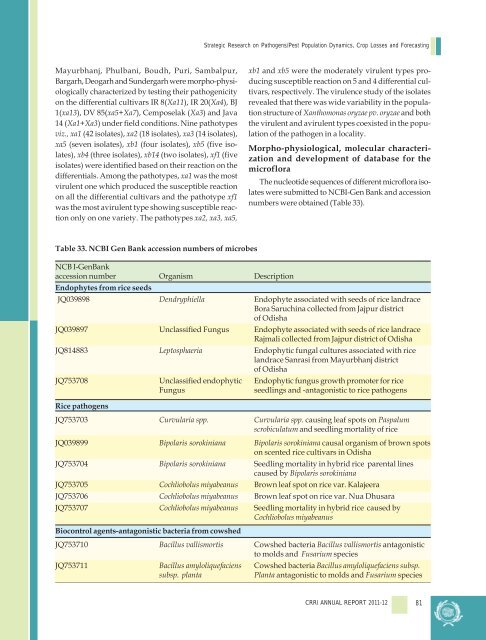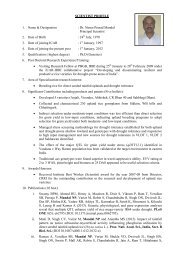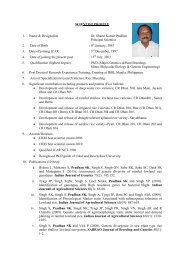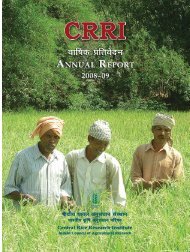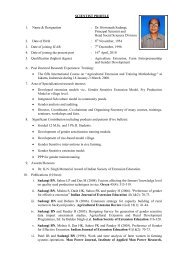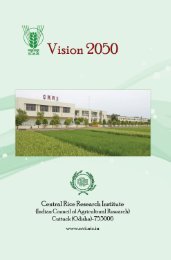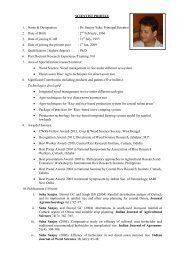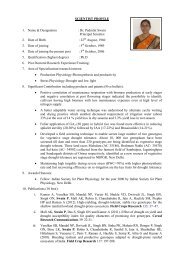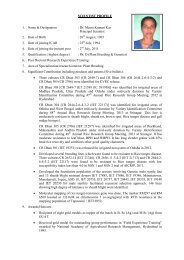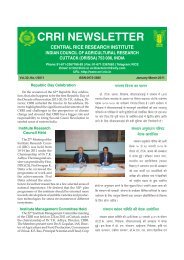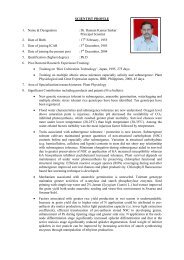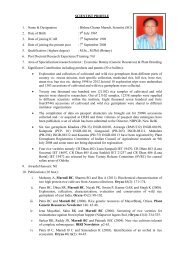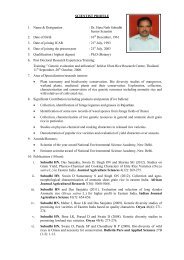Central Rice Research Institute Annual report...2011-12
Central Rice Research Institute Annual report...2011-12
Central Rice Research Institute Annual report...2011-12
Create successful ePaper yourself
Turn your PDF publications into a flip-book with our unique Google optimized e-Paper software.
Strategic <strong>Research</strong> on Pathogens/Pest Population Dynamics, Crop Losses and Forecasting<br />
Mayurbhanj, Phulbani, Boudh, Puri, Sambalpur,<br />
Bargarh, Deogarh and Sundergarh were morpho-physiologically<br />
characterized by testing their pathogenicity<br />
on the differential cultivars IR 8(Xa11), IR 20(Xa4), BJ<br />
1(xa13), DV 85(xa5+Xa7), Cemposelak (Xa3) and Java<br />
14 (Xa1+Xa3) under field conditions. Nine pathotypes<br />
viz., xa1 (42 isolates), xa2 (18 isolates), xa3 (14 isolates),<br />
xa5 (seven isolates), xb1 (four isolates), xb5 (five isolates),<br />
xb4 (three isolates), xb14 (two isolates), xf1 (five<br />
isolates) were identified based on their reaction on the<br />
differentials. Among the pathotypes, xa1 was the most<br />
virulent one which produced the susceptible reaction<br />
on all the differential cultivars and the pathotype xf1<br />
was the most avirulent type showing susceptible reaction<br />
only on one variety. The pathotypes xa2, xa3, xa5,<br />
xb1 and xb5 were the moderately virulent types producing<br />
susceptible reaction on 5 and 4 differential cultivars,<br />
respectively. The virulence study of the isolates<br />
revealed that there was wide variability in the population<br />
structure of Xanthomonas oryzae pv. oryzae and both<br />
the virulent and avirulent types coexisted in the population<br />
of the pathogen in a locality.<br />
Morpho-physiological, molecular characterization<br />
and development of database for the<br />
microflora<br />
The nucleotide sequences of different microflora isolates<br />
were submitted to NCBI-Gen Bank and accession<br />
numbers were obtained (Table 33).<br />
Table 33. NCBI Gen Bank accession numbers of microbes<br />
NCB I-GenBank<br />
accession number Organism Description<br />
Endophytes from rice seeds<br />
JQ039898 Dendryphiella Endophyte associated with seeds of rice landrace<br />
Bora Saruchina collected from Jajpur district<br />
of Odisha<br />
JQ039897 Unclassified Fungus Endophyte associated with seeds of rice landrace<br />
Rajmali collected from Jajpur district of Odisha<br />
JQ814883 Leptosphaeria Endophytic fungal cultures associated with rice<br />
landrace Sanrasi from Mayurbhanj district<br />
of Odisha<br />
JQ753708 Unclassified endophytic Endophytic fungus growth promoter for rice<br />
Fungus<br />
seedlings and -antagonistic to rice pathogens<br />
<strong>Rice</strong> pathogens<br />
JQ753703 Curvularia spp. Curvularia spp. causing leaf spots on Paspalum<br />
scrobiculatum and seedling mortality of rice<br />
JQ039899 Bipolaris sorokiniana Bipolaris sorokiniana causal organism of brown spots<br />
on scented rice cultivars in Odisha<br />
JQ753704 Bipolaris sorokiniana Seedling mortality in hybrid rice parental lines<br />
caused by Bipolaris sorokiniana<br />
JQ753705 Cochliobolus miyabeanus Brown leaf spot on rice var. Kalajeera<br />
JQ753706 Cochliobolus miyabeanus Brown leaf spot on rice var. Nua Dhusara<br />
JQ753707 Cochliobolus miyabeanus Seedling mortality in hybrid rice caused by<br />
Cochliobolus miyabeanus<br />
Biocontrol agents-antagonistic bacteria from cowshed<br />
JQ753710 Bacillus vallismortis Cowshed bacteria Bacillus vallismortis antagonistic<br />
to molds and Fusarium species<br />
JQ753711 Bacillus amyloliquefaciens Cowshed bacteria Bacillus amyloliquefaciens subsp.<br />
subsp. planta<br />
Planta antagonistic to molds and Fusarium species<br />
CRRI ANNUAL REPORT 2011-<strong>12</strong><br />
81


